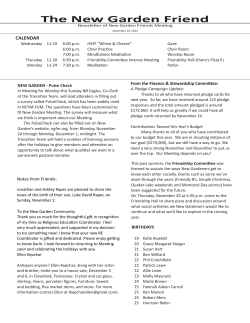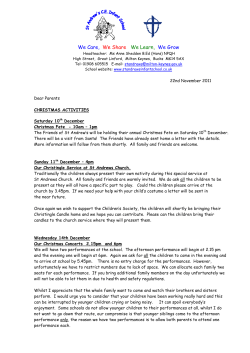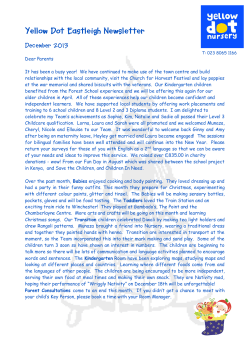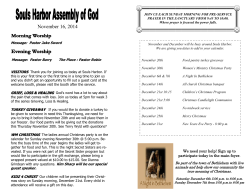
Dec 2014 - Alabama Cooperative Extension System
* Garden Volume 23 Issue 12 Buzzzz Central Alabama Master Gardener Association * December 2014 President’s Message By Linda Griebel Table of Contents: Seems like falling leaves come with falling temperatures. Not my kind of weather, but I do have to keep perspective when I see the extreme snowfalls farther north. That would really be disheartening to southern gardeners. Perhaps we can finally get some items dug up and transplanted, hoping that we get some much needed rain. Then the ground might be more workable too. At least, we do get a few warmer days when we can get outside and accomplish those necessary tasks. Our interns have just completed the required coursework and can now continue with their hands-on development. It’s so nice to see many of you at meetings and participating in volunteer activities already. We have all been there and can relate to your plight. All of us hope to be able to continue to share our knowledge as well as plants with our newest members. You bring so much enthusiasm and new ideas into our fold. While we celebrate the accomplishments of the intern class of 2014, it’s also a good time to start recruiting for next year’s class. We’ll finish out this year with the Christmas get together – hope everyone can attend and enjoy the food and socializing. It’s always a very nice gathering – and we won’t have to cook for this one. I’m looking forward to it. As for next year, plans are underway for a brand new Lunch and Learn series; innovative presentations and informative speakers for meetings; new and continuing projects; and Bonsai and perhaps additional training for master gardeners. Please feel free to join in and contribute where ever possible. Our association always accomplishes so very much because of our members. See you in the gardens. Linda President’s Message. . . .1 Mallory Kelley . . . . . . . . 2 December Calendar. . . . 3 Minutes. . . . . . . . . . . . . 4-6 Announcements. . . . . . . .7 Spotlight . . . . . . . . . . . . . .8 Governor’s Mansion. . . . 9 Bugs Webinar . . . . . . . . . .8 September Meeting . . . . 9 Christmas Party . . . . . . .10 Gardener’s Calendar. . . 11 Search for Excellence. . 12-15 Learning Garden. . . . . . 16 Fern Program. . . . . . . . . 17 Lunch ‘n’ Learn . . . . . . . .18 Program Notes . . . . . . . .19 Garden Buzzzz December 2014 Page 2 Message from Mallory By Mallory Kelley Selecting a Locally Grown Christmas Tree Can you believe Christmas is right around the corner? Next week many people will start putting up there Christmas trees. Here are some helpful tips and things to consider when purchasing a Christmas tree. You often hear “Buy Fresh, Buy Local” and that not only goes for fruits and vegetables, but also Christmas trees. There are many advantages to buying an Alabama-grown Christmas tree instead of an artificial tree or a live tree grown in another state. Alabama has between 50 and 60 Christmas tree growers representing a $3 million industry which helps the economy of Alabama, but there are also many other benefits to buying a local Christmas tree. Buying a locally grown Christmas tree guarantees its freshness. From the standpoint of freshness, Alabama-grown trees have a distinct advantage as they are chosen and cut from the farm nearby. In contrast, many of the trees you purchase at grocery stores or other retail outlets --- typically firs, spruces and scotch pines were grown in another state and were likely cut weeks earlier which tells me they will be shedding their needles in my living room. With an Alabama farm-grown tree, you’re also buying a unique experience. Choosing and cutting a tree from an Alabama farm guarantees you and your family the freshest trees that will last much longer and a Christmas memory that you will cherish for a lifetime. So if you are heading out to a Christmas tree farm in Alabama, what type of trees will you find and what should you be looking for? The most popular Alabama-grown tree is the Leyland cypress tree (widely known as the Southern Christmas tree), the Arizona cypress which is typically available in two varieties, ‘Blue Ice’ and ‘Carolina Sapphire’ and the Virginia pines. The Leyland cypress has a natural color and, unlike many northern-grown varieties, it doesn’t shed after cutting. In fact, as long as it receives an adequate amount of water, Leyland cypress trees can last from Thanksgiving well past New Year’s. A few people still prefer the red cedar, though one disadvantage is that they are extremely sticky compared with other varieties. Still, it remains the preferred tree among a small number of Alabamians who remember this very fragrant tree from childhood. Leyland and Arizona cypress trees are considered especially safe for the home and are far less prone to drying than northern-grown trees such as firs and spruce. Fir and spruce trees are characterized by heavy sap which tends to clog after the tree is cut and prevents the uptake of water causing the tree to dry out much fast resulting in needle shed. If you prefer not to cut down a tree only for a few weeks of decorations there are other alternatives. Christmas trees that either have been bagged in burlap or planted in a container have become a popular alternative for environmentally conscious consumers. It’s best to keep these trees away from heaters or warm areas in the home. Otherwise, the tree will have a harder time adapting to the colder conditions outside after planting. Also, avoid buying live firs and spruce trees as neither of these are adapted to Alabama’s warmer climate. The Leyland and Arizona cypress make excellent additions to the landscape and are well-suited as screening plants. However, they grow to be very large trees, as high as 50 feet and should be planted at least 12 feet apart. For this reason, many homeowners would not find it practical to plant a live tree every year after Christmas. Finally, if you do decide to go to the farm and cut that locally grown Christmas tree make sure you recycle it. Many communities throughout Alabama have established Christmas tree recycling programs. You should call your city hall for more details. Source: Dr. Ken Tilt, Professor of Horticulture, Auburn University Garden Buzzzz December 2014 Page 3 Calendar of Events December 2014 Sun 7 Mon Tue 1 2 Governor’s Mansion Work Day Learning Garden Work Day 8 9 Governor’s Mansion Work Day Learning Garden Work Day 14 15 16 Christmas Home Tour Chilton County Governor’s Mansion Work Day 21 22 CAMGA Meeting Christmas Party Wed 3 4 10 17 11 12 13 18 19 20 Deadline Beekeeping Course on January 8 Lanark Work Day 24 Christmas Eve 29 30 6 Lanark Work Day 25 Christmas Winter Solstice 5 Sat Capitol Steps Hanukkah Begins 23 Fri Every Light a Prayer for Peace Lanark Work Day Winter Solstice 28 Thu 31 New Year’s Eve 26 27 Garden Buzzzz December 2014 October Minutes Page 4 By Rosemary Mobley, Secretary The November, 2014, Central Alabama Master Gardener’s Association (CAMGA) meeting was held November 19, 2014, at Historic Lanark, 3050 Lanark Road, in Millbrook, Alabama. Linda Griebel called the meeting to order at 10:03 a.m. She welcomed everyone, and asked interns in attendance to stand for recognition. Interns at the meeting were: Cheri Bedford, Terry Chambliss, Peggy Gelpi, Mike Harber, Don Hoover, James May, Linda Queen, Sandy Rosamond, Darla Tiesling, and Joyce Vella. Next, Linda recognized Carol Rattan, who introduced the speaker, Maria Pacheco-West, Lanark Grounds Specialist and Tour Coordinator. Maria is also a CAMGA member who coordinates ongoing volunteer projects in the 40 acres of Lanark Gardens. She invited master gardeners to come to Lanark on Wednesdays from 8:00 a.m. until 11:00 a.m. and help “keep the gardens beautiful.” Maria shared that the grounds are open to the general public on the third weekend of each month. A special guest, Santa Claus, is visiting Lanark on December 20th! For more information about Lanark and other Alabama Wildlife Federation events, refer to: www.alabamawildlife.org . Maria began her session on ferns by sharing a tip she learned in caring for these plants. She noted that in her experience, ferns do not respond well to commercial fertilizers. However, a home made solution has positives results with ferns. The solution she referenced consists of 1 tablespoon of Epsom salt diluted with 1 gallon of water. This solution is applied once every four weeks. For best results, pour the solution onto the plant and soil, rather than misting the solution on fern fronds. Ferns are seedless vascular plants with spores rather than seeds. Most ferns have what are called fiddleheads that expand into fronds. Maria illustrated the fern life cycle by circulating among attendees a fern frond (mature sporophyte) with “brown dots” (sori) on the underside. The sori contain spores that will be released into the environment. In perfect conditions, spores find the right amount of water and light, and begin growth. These spores form tiny plants or gametophytes that contain both male and female cells. When fer- tilization occurs, a new sporophyte is formed, and grows into the plant we know as a fern. Fern fronds vary greatly in size, from tree ferns with very large fronds to barely visible aquatic fronds. Maria described some types of ferns. 1) The cinnamon fern receives its name from the younger fronds, which start out bright green before turning cinnamon in color. 2) The roots of royal fern are used for the production of osmunda fibre, used as a growing medium for cultivated orchids. 3) Resurrection fern is a remarkable plant that is found throughout the southeast. This fern grows on top of other plants, using them as anchors, without getting nutrients from the host plant. In times of drought, this plant shrivels up but does not die. With the addition of water, the plant returns to its original shape and color. 4) Mariana fern is a fast-growing fern with large, pale-green fronds. This fern prefers indirect sun but will tolerate full sun in moist soils. 5) The rabbit’s foot fern gets its name from the furry rootstock that grows on top of the soil and resembles a rabbit’s foot. 6) Bracken is an invasive fern that tends to expand rapidly, and at the expense of other plants. She added that asparagus fern and foxtail fern are not true ferns as they are multiplied from seeds. Two publications were referenced. These were: Ferns of Alabama by John W. Short and Daniel D. Spaulding, and A Field Guide to Ferns and their Related Families by Boughton Cobb. After a break for refreshments, the business meeting convened at 11:05 a.m. Linda informed members that donations of peanut butter and / or cash may be made to the Elmore County Food Pantry at the Christmas Luncheon. She explained that it was time to think about CAMGA’s item for the silent auction at the State Master Gardener’s Conference to be held on March 23-25, 2015, in Cullman, Alabama. Candy Jones made a motion to spend up to $50.00 for the silent auction item. Johan Beumer made the second motion, and it was carried by all present. Linda recognized Carol Rattan who provided an update on plans for the Christmas Luncheon. Garden Buzzzz December 2014 Page 5 A Christmas luncheon will be held on December 16, 2014, from 10 a.m. until 12:00 p.m., at Mulder Memorial United Methodist Church. This is the regularly scheduled CAMGA meeting date as well. Sign-up sheets for attendance, help with decorations, set-up and clean-up were available. The cost per person for the luncheon is $12.00, and Carol asked that payments be made by the week before the luncheon so that an accurate count is given to the caterer. Carol shared that the menu will consist of baked chicken, green beans, macaroni and cheese, and desserts. Mary Long and Carol Rattan will provide the music. The Treasurer, Rebecca Ashurst, is the point of contact for luncheon payments. Becky Ashurst gave the October Treasurer’s Report. The balance as of October 31, 2014 was $11,111.13. Income for October consisted of a $25.00 speaking donation. Expenditures for October were Water Feature Repairs- $ 46.71, Postage-$1.82, and Speaker Fee- $35.00 which totaled $83.53. This left a balance as of October 31, 2014 of $11,052.60. Mary McCroan made a motion to approve the Treasurer’s report. Candy Jones made the second, and it was carried by all present. Becky announced that is was time to pay local and state dues which total to $20.00. A check payable to CAMGA may be made which includes state and local dues and Christmas lunch. Current interns do not pay dues for next year. Next, Gale Wheeler-Leonard reported on the Nov 5, 2014, Advisory Council meeting. The Chilton County Master Gardeners invited CAMGA members to a Christmas Home Tour on December 14, 2014, from 1:00- 4:00 p.m. to start at the Chilton County Extension Office. Tickets are for sale at $15.00 in advance and $20.00 on the day of the tour. Anida Wishnietsky will provide more details about this event in an e-mail sent to all members. Gale also noted that she sent a card to Jane Mobley for her recent illness. She encouraged everyone to let her know about any CAMGA members who are ill. Linda Griebel reported for the Projects Committee. She noted that Jane Mobley is completing a design for the Butterfly Garden. The project slated for the Elmore County Municipal Courthouse is tabled for the near future waiting on more input. The bonsai class is on schedule for March 5, 2015, and the class size is limited to 20. Some slots are still available. A sign-up sheet will be available at the December meeting. A price for this class will be finalized in January, 2015. John Barnes researched the price of a table-sized banner to display at community events. The cost for the banner was reported at $60.00. Bonnie McCormick made a motion to spend $60.00 for a CAMGA banner. Catese Chaffee made the second, and it was carried by all present. The President recognized Amanda Borden, Sandy Rosamond, and Terry Chambliss, who worked on Nov 17th at the Governor’s Mansion. She asked everyone who volunteered at Lanark Gardens to stand for recognition. Linda urged attendees to check their information in the directory and report any edits and changes to Ann Hill. She also noted that Sally and Joe L’Abbe, in their capacity as County Extension Office Committee, recently assisted with a large mail-out. Member’s volunteer hours should be entered before the end of the year so that Rhona Watson will have the information necessary for the Reach for the Stars Program. Mary McCroan addressed the group on plans for the Community Learning Gardens. She passed around French sorrel that she planted in the gardens. Tasters could tell why this herb is called “lemonade in a leaf.” She also shared a recipe that she tried using the sorrel. Next, Mary stated that all of the gardens were in need of additional soil which will cost $560.00. Catese Chaffee moved that $560.00 be used to purchase soil for the Community Learning Gardens. Amanda Borden made the second, and it was approved by all present. Next, Mary added that the area in front of the building requires mulch which should cost $50.00. Peggy Turnipseed made a motion for $50.00 to be provided for mulch. Rosemary Mobley made the second, and it was carried by all present. Becky Brown, chair of the Class for Interns Committee, expressed that she was glad that so many interns were at the meeting. The last intern class will be held on Nov 20, 2014. Becky thanked all those who helped with the classes. Graduation is scheduled on August 18, 2015, at Mulder Methodist church. She asked members to start recruiting interns for next year. Garden Buzzzz December 2014 Page 6 The Lunch and Learn Committee is firming up the speakers for next year’s sessions. Starting in January 2015, Lunch and Learn meetings will be held on the second Tuesday of the month. The December 10, 2014, Lunch and Learn will feature Phil Easter sharing information about Holiday Plants and Forcing Bulbs. Jane Mobley reported that the scrapbook for the current year is in good shape, but she still needs pictures and articles to complete the year. Bob Brown recognized our President, Linda Griebel, for authoring excellent monthly articles on gardening for the Elmore County Magazine. Linda stressed the importance of keeping all publicity going through Phil Easter, the Publicity chairperson. She also encouraged everyone to submit newsletter articles and pictures to Mary Long before the Thanksgiving holidays. Mallory Kelly thanked Bob and Becky Brown for all of their efforts in coordinating the intern class. She also thanked Rosemary Mobley, Red Norman, and all CAMGA members for their help with the lunches, mentoring, and grading. Mallory informed the group that updated applications for next year’s intern class are available in the Elmore County Extension Office. New applicants will enter personal information for the background check at the Auburn Protect online site rather than on the paper application. Johan Beumer asked about the cost for the next intern class. She answered that the spring, 2015 classes in Montgomery and Lee Counties will remain $125.00. However, costs for fall, 2015 classes are under consideration, and may increase by $25.00. Mallory shared that the Helpline Luncheon will take place in January. She stated that anyone needing a new badge should let her know as soon as possible, as she will be ordering them soon. The cost for a regular badge is $7.00. Bonnie McCormick announced that Sherry Scott, who was present at the meeting, has been a CAMGA member for 21 years! Linda thanked Maria Pacheco-West for the presentation and for her hospitality. The meeting was adjourned at 11:50 a.m. Forty-one people attended. Respectfully submitted, Rosemary Mobley, Secretary "Lanark Workday Each Wednesday 8 am until 11 When Wednesday October 22 2014 8:00 AM to 11:00 AM Where Alabama Wildlife Federation 3050 Lanark Road — Millbrook, AL Notes : Maria Pacheco-West, 334-285-4317, MPW@alabamawildlife.org THANK YOU….from the editor A special ‘Thank you’ to Anida Wishnietsky for finishing the Buzzzz for me in November. I was on a week-long trip to Galinburg and was unable to get it all done before leaving. Anida always comes through in a pinch with very little advance notice. THANKS, ANIDA !!! ——Mary Long Garden Buzzzz December 2014 Holtville Junior Master Gardeners Suzanne George has led the Holtville Middle School Junior Master Gardener program for a couple of years now and has done a great job!! She is really in need of help. We’re putting out a plea to MG’s and interns to see if any one happens to live in the Holtville area and who may be interested in helping her. At the moment, helpers would not have to be Junior Master Gardener certified, we can work toward getting that taken care of. Right now, she generally meets with the 21st Century program after school there 2 times each month. BEEKEEPING COURSE The Tallapoosa County Extension Office will host a 2015 Beginner Beekeeping Course starting January 8, 2015. It will again be held on Thursday nights in Dadeville from 6 to 8 p.m. Mr. Damon Wallace, a Master Beekeeper, will return to teach and lead the seven week course. Cost of the series is $45 per person, and includes two textbooks. Cost is $75 for couples. Registration information / flyer can found at www.aces.edu/Tallapoosa. Payment and sign-up deadline is December 19th. Please share with anyone you know who might be interested. Thanks. Shane Harris County Extension Coordinator – Tallapoosa Alabama Cooperative Extension System 125 N. Broadnax Street, Room 23 Dadeville, AL 36853 256-825-1050 (office) 256-596-1363 (cell) Page 7 CAMGA Welcomes Two New Members Jerry Belcher 263 Lakeshore Dr. Pike Road, AL 36064 jerrybelcher66@gmail.com 334-467-5534 intern Montgomery 2010 Local only Sheila Ward 1967 Coosa County Road 37 Rockford, AL 35136 wardgrand6@gmail.com Graduating Coosa County this month State and Local I have emailed her for phone number. 2014 Lunch and Learn Programs Second Wednesday Each Month 12:00 to 1:00 *DECEMBER 10TH HOLIDAY PLANTS & FORCING BULBS Be sure to catch Phil Easter and L&L presenter every 2nd Monday on WSFA ‘12 Talk’ or sometimes ‘Alabama Live’ TV Show. (11 to 12:30 timeframe) Garden Buzzzz December 2014 SPOTLIGHT ON VOLUNTEERS Page 8 by Judy May Attending the Projects committee meeting this month were John Barnes, Linda Griebel, Lois Pribulick, Candy Jones, Jane Mobley, Mary McCroan and Johan Beumer. Lunch and Learn volunteers this month were Carla McCune, Deborah Kelso, Sandi Adkinson, and Charlotte Hall. Those bringing the lunch and staying to eat with the interns were board members Linda Griebel, Iva Haynie, Mary Long, John Barnes, Mary McCroan, Becky Ashurst, and Ann Hill. The presenters were Rosemary Mobley and Charlotte Hall who were speaking on Christmas Decorations with Natural Materials. On November 4th working in the Community Gardens were John Barnes, Rosemary Mobley, Terry Chambliss, Cherri Bedford and Linda Griebel. Gale Wheeler –Leonard and Linda Griebel attended the AMGA Advisory Council meeting on November 5. Phil Easter did a class for AUM Seniors on Decorating with Materials from the Landscape on Wednesday, November 5th. He did a Lunch and Learn WSFA-TV promotion with Rosemary Mobley on November 5th at WSFA, and is getting information to the Alabama Gardener magazine for our Lunch and Learn in January, February and March. On November 12, Lee and Amanda Borden presented “Growing Fruit at Home” to the Gardening class at AUM’s Center for Lifelong Learning. Mary McCroan and Linda Griebel presented “Pruning Pointers for Southern Gardens” on November 13th to the CAMGA intern class. During November, Amanda Borden, Sandy Rosamond and Terry Chambliss joined Jane McCarthy as volunteers at the Governor’s Mansion. Becky Brown says Test Graders for the Master Gardener intern class this month were Charlotte Hall, Carla McCune, Andy Wallace, Lee Borden and Ricky Hatcher. Rosemary Mobley says helping with food for the intern class October 30 th were Charlotte Hall, Mary Lou Mullins, Penny Arceneaux, Marie Updike, Katrina Mitchell, Rosemary Mobley and Red Norman. November 6th Iva Haynie, Amanda Borden, Charlotte Hall, Marie Updike, Sharon Potts, Catese Chaffee, Rosemary and Red Norman supplied the food. On November 13th Board members Becky Brown, Iva Haynie, Mary Long, Ann Hill, John Barnes, Mary McCroan and Linda Griebel supplied food for the class. Maria says she has been cutting back on future work in the gardens by removing unnecessary features and whacking back the azaleas (yes, I know it is the wrong time of the year, but we have to do what we can, when we can do it). The following have helped her tremendously in getting things under control: Connie Willis, Carla McCune, Norman Turnipseed, Ann Hill, and interns: Peggy Gelpi and Don Hoover. She says Sandra Gilley helped her get to Petal’s from the Past and to Green Thumb to get annuals fall and winter plants. Thanks for all the help. Lanark looks neater and more beautiful because of you. Consider working in the Lanark Gardens this winter. You never know what we might do, and you might just have fun! Two intern class volunteers who are extremely helpful are Red Norman and Rosemary Mobley. They did wonders with having CAMGA members bring lunches for the class, as well as adding a surprise dish of their own making each week. They decorated the table on Wednesday afternoon. Thursday they readied the food, cleaned up after lunch and were quietly gone in record time. All this done without disturbing the instructor. Garden Buzzzz December 2014 Page 9 Governor’s Mansion Report By Jane McCarthy During the month of November, volunteers at the Governor's Mansion weeded beds and the herb garden and trimmed back dead plants. They planted boxwoods and holly ferns, and relocated some knockout roses, camellias, and hydrangeas to more appropriate locations on the property. In the photo: CAMGA members Sandy Rosamond, Amanda Borden, Jane McCarthy, and Terry Chambliss (L to R) after plant relocation. Garden Buzzzz December 2014 CHRISTMAS PARTY By Anida Wishnietsky This year's Christmas Party will be at Mulder Memorial United Methodist Church at 3454 Fire Tower Road (Hwy 59) in Wetumpka on Tuesday, December 16th from 10 am until noon. This is the same location as last year. Anyone attending the Christmas Party must pay $12 per person attending because the lunch is catered. We need a check no later than December 9th so we'll know how much food to plan for and how many tables to set up. If you are interested in making a donation to the Wetumpka Food Pantry again this year, we will be collecting peanut butter and cash/check donations at the meeting/party. While you are writing your $12 check ($24 if you are bringing a friend or spouse) to attend the Christmas Party, then you might want to add another $20 (local & state) or $12 (local only) for your 2015 dues. Interns do not pay dues for 2015, but continue as CAMGA members and are able to attend the meeting/ party. Please make the check out to "CAMGA" and mail it to treasurer Becky Ashurst , 775 Morgan Trace, Wetumpka, AL. 36093. Dues are due by December 31, 2014. Indicate on the check what you are paying for (i.e. number for memberships, state and local dues, and number of people attending the Christmas party). Page 10 We’re Invited We would like to invite Elmore Master Gardeners to our annual CHRISTMAS HOME Tour on December 14, 2014, from 1:00 - 4:00 PM. The tickets are $15.00 in Advance and $20.00 on the day of. The tour starts at the Chilton Co. Extension Office. Please invite your Association. For information contact the Extension Office at 205-755-6268 or call Alice Broome at 205-755-0372. Tickets can be purchased on our CCMGA website at http://ccmga.aces.edu/december-14-2014 -christmas-home-tour/. Thanks, Lanell Baker, Secretary, CCMGA This is a tour of four homes that will be decorated with the homeowners decorations and with greenery, berries, vines etc. added from our gardens. But, no, there will not be any gardens toured just the decorated homes. One of the homes is in Thorsby, an old Victorian Home remodeled back to it's original splendor, and three are in Clanton. Directions to each home will be on the tickets and the tickets will have to be presented at each home. Refreshments will be served at the Chilton County Extension Office , 504 1st Ave., (behind the City Hall) from 12:30 PM until 4:30 PM and they will get you started on your tour. Your may go to our website http:// ccmga.aces.edu, and see pictures of the homes to be toured and you can also purchase tickets from the website. Thanks for your interest and if you need more information, please let me know. Lanell Baker, Secretary, CCMGA Garden Buzzzz December 2014 Page 11 Alabama Gardening Calendar—December Fruits and Nuts • Plant young pecan and other deciduous fruit trees and grapes. • Start dormant pruning of established fruits. • Protect all young trees from rabbit damage by placing wire around the base of the tree. • Put on dormant oil spays for scale. Shrubs • Planting is still the main activity but delay in case of freezing weather. Roses • Add plants to rose garden. • Mulch all plantings. Annuals and Perennials Plant hardy annual seed without delay. Set out pansies and violas Bulbs • Continue spring bulb planting. Garden Buzzzz December 2014 Page 12 Kerry Smith is encouraging all MG organizations to select a favorite project from this year and submit it to Search for Excellence program whereby groups can win an award for their project. MASTER GARDENER SEARCH FOR EXCELLENCE GUIDELINES (adapted for Alabama from the IMGC guidelines) Search for Excellence recognizes Master Gardener projects throughout the United States and Canada. It was developed by the International Master Gardener Conference Committee. The award has seven categories to describe the outstanding contributions of MGs to their communities. All SFE applications must show that significant learning took place. All volunteer work done by Master Gardeners is significant to their communities, but not all is a Search for Excellence project. Determine if your project meets the SFE guidelines 1. First it must fit into one of the seven categories a. Youth Programs b. Demonstration Garden c. Workshop or Presentation or Hands-on Programs d. Community Service e. Innovative Projects f. Special Audiences, Senior/Disabled Audiences or Hort Therapy Other or General MG Accomplishment Your project may cover more than one category, but choose one main category to describe it. It must have completed at least one cycle and be an ongoing project. Previous SFE winners are not eligible for a second award for the same project. 2. Search for Excellence is designed to recognize a group project, not an individual who does outstanding work. AMGA has several awards that recognize outstanding individual Master Gardeners. 3. It must be simple to replicate. A goal of SFE is to share the excellent ideas and programs so they (or parts) can be replicated by other MG groups. Example: A 20 acre botanic garden would be difficult to replicate, but the gardening ideas inside it would be easy to create somewhere else. A step by step “how to do this” would be a great way to share your project. 4. It must be practical for its designed audience. A SFE program is one that is easy to use and fits well for the situation it is intended for. A practical project finds the best way possible to meet a need in the community. 5. It should be original and creative. We don’t want you to recreate the wheel, just maybe parts of it so that it's unique to your situation. We are looking for that added touch that makes this project your own. 6. It should meet the Extension and Master Gardener missions. a. All projects should have an educational component. Applications should show how your group changed or affected peoples' lives. It is important to show what was learned. b. All Extension and MG programs are available to all persons without regard to race, color, sex, disability, religion, age, veteran status, political beliefs, sexual orientation, national origin, and marital or family status. c. All Extension and MG programs should extend the resources of the University to the public wherever they live, helping them use knowledge to solve problems at work, at home and in their communities. d. Information provided should be research-based. The project application should be written by the Master Gardeners involved, not Extension staff. Use each of these criteria and provide your response in a Word-type document. Apply for this award (the application format) 1. Name of your MG Association and location 2. Name, title, address, phone, email of MG Coordinator/Extension staff 3. Name, title, address, phone, email of MG Contact person 4. Name of Project 5. Category. Select and submit in only one category 6. Names of Master Gardeners involved in project from start to finish. Please don’t include any other individuals in this listing. 7. Description of Project. Include instructional methods – planning & implementation of project/instruction, number of participants, results – learning & impacts in participants, budget narrative. Describe how this project is a good candidate for SFE and could be repeated by others. a. Simple to replicate (methods) b. Practicality (methods, budget) c. Originality/creativity (methods, budget) Garden Buzzzz December 2014 Page 13 d. e. f. g. h. i. j. k. l. m. Extension and MG Mission/Goals (methods, results) Significant learning and impacts (results) Number of people impacted (number) Support from other community groups (methods, budget, results, numbers) Budget (budget) Verification letter with three signatures Other considerations for the application: Be as creative in your description as you can. Limit application to 3 pages, single-spaced. The verification letter (see item 8) can be page 4. The verification letter shows that the MG's involved are in good-standing with their local program. This may be a short, formtype letter written by the applicant and signed by the verifying agents. Three verifying signatures are required: the local MG association president, the sponsoring ACES agent, one community representative. The community representative should be someone who participated in the project or someone from a cooperating community group with this project. n. DO NOT include any pictures. If your project is selected as a winner, digital pictures will then be requested from you. o. Please don’t send a huge file with your handouts, etc.; just the three page document and the verification letter. These applications may be sent by email to smithkp@auburn.edu . Details to consider for the Project Description: Significant learning is one area that we need to encourage and should emphasize. The teaching and service done by Master Gardeners is excellent. We may have evaluations that tell us that the speaker was good, the class was fun or the room was comfortable but these don’t show if or how we made an impact. These questions describe what was taught. We should also be describing the amount of learning. All of Extension is being asked to show impact or “How a person’s life will be changed by what we do”. It is important to show what was learned by either the MG or the participants. Following are some examples. Questions that ask, “How do you plan to use this information?” or “Can you share specific information that you learned today?” can help to show impact. An example: you show that 70% of the participants plan to trellis and prune their muscadines in the way taught. Consider open-ended questions that allow participants to write out what they learned. How many people and Master Gardeners were impacted. Did you reach the most people possible? A SFE project will help to make your community (however you describe that to be) a better place. CRITERIA FOR SELECTION...100 point scale. Simplicity of project (easy to replicate)....10 points Practicality, usefulness or relevance of project for situation...10 points Originality or creativity....10 points Consistent with Extension and MG missions...20 points Clarity and completeness of project application...20 points Did significant learning occur?...20 points Number of people impacted...10 points TOTAL..................100 points Expectations if awarded: (adapted for Alabama) If you are selected as a Search for Excellence winner, you will be expected to create a display about your project. The State Coordinator will need digital images to use in a Powerpoint presentation at the award ceremony. There are potentially seven winners each year. Mail or email applications to Kerry Smith, Alabama Master Gardener State Program Coordinator. Applications are due to the State MG Program Coordinator by January 1. We applaud all of the volunteer work done by Master Gardeners. We hope this award from the Alabama Cooperative Extension System will further show our appreciation of your efforts. Thank you for your interest, Kerry Smith 101 Funchess Hall Auburn University, Alabama 36849 334-844-3036 smithkp@auburn.edu Garden Buzzzz December 2014 Search for Excellence Award Application (Please limit this application submission to 3 pages, not including the verification letter) Name of MG Association/Program: County: Master Gardener completing Application: Name: Email: Address: Phone: Local Master Gardener Coordinator/ACES Staff: Name: Title: Email: Address: Phone: Category for Submission: ____Youth ____Demonstration garden ____Workshop or presentation ____Community Service ____Innovative Project ____Special Needs Audience ____Research (applied scientific methodology) Name of Project: Description of Project:* (Include target audience, goals for impact, location and partnerships) Page 14 Garden Buzzzz December 2014 Page 15 Methods: (Describe the planning and implementation of the project – what type of instruction or program was offered, describe the content and the number of participants who benefited) Results: (Describe the learning and impacts – predicted and/or not predicted – within the participants who benefited from this project) Significant Learning and Impacts: Budget Narrative: Names of All Active Master Gardeners Directly Involved in the Project: (remember to also include a verification letter – see SFE application description) *Details to consider for the Project Description: Significant learning or community impact must be illustrated. Program evaluations may tell us that the speaker was good, the class was fun or the room was comfortable but these don’t show if or how we made an impact. How did your project/program change someone’s life or behavior? Questions that ask, “How do you plan to use this information?” or “Can you tell us a specific detail that you will take home and use?” will help to show impact from your program/project. An example: you show that 70% of the participants plan to install drip irrigation after your demo; or they plan to start doing a soil test before fertilizing; or in follow-up you find that more people are walking in the park after your landscape improvements compared to prior. Don’t offer canned answers that they choose from, let them write out what they learned, or how the project has changed what they do. Garden Buzzzz December 2014 Page 16 Learning Garden Report By Mary McCroan It has been a fairly quiet month in the Learning Garden so far. One nice addition is that Linda Griebel donated and planted a Fig Tree to add some more variety to our small orchard. The fall veggies include cabbage, mustard greens and collard greens that have grown well and so far handled the cold weather. However, the Chard and French Sorrel looked frost nipped and will not last much longer. On a happy note, the French Sorrel is perennial and will come back next spring. I talked about making French Sorrel soup at the November CAMGA meeting and posted the recipe on our facebook page. My source for the French Sorrel seeds is bountifulgardens.org. They sell a variety of perennial veggies and I grown several in the Learning Garden. So far only the French Sorrel has actually been perennial. Ones that did not do well were Sea Kale, Good King Henry Greens and Perpetual Spinach Chard. The Chard has done well as an annual, but did not handle our cold temperatures last year. I think I will try tree collards next! More info on French Sorrel: - It is cold-hardy perennial that does well in our area. - Leaves are the plants’ edible parts, and new sorrel leaves emerge from the plants’ centers for several months, from late winter to late fall. - Sorrel has a lemony taste and is a perfect base for sauces that accompany poached eggs and fish. It is also eaten raw in salads or on sandwiches (where a little goes a long way), or cooked into creamy sorrel soup. Flavors are stronger in the fall versus the new growth in the spring. - It is easy to grow in sun or partial shade. - Sorrel can be propagated from seed two weeks before the last frost date or you can cut away rooted crowns from the outside of established plants and move them to a new location in early spring. Plant them 18 to 24 inches apart. - Sorrel does well when planted in raised beds with enriched soil and improved drainage. - Add compost in spring and again at mid season. - Companion plants: Strawberries. Garden Buzzzz December 2014 CAMGA November Meeting Page 17 Interesting Fern Program at Lanark Fern Life Cycle At our November meeting Maria PachecoWest of the Alabama Wildlife Federation and also one of our own CAMGA’s gave a delightful program on the ferns that grow at Lanark. She had many freshly gathered fronds to demonstrate. She mentioned that Dr. Dan Jones, fern expert of Birmingham, says that the two books pictured at left are the best ones to help us identify ferns. Other books aren't as professional and may have misleading information. She explained the life cycle of ferns and gave a chart showing how the fern goes from spore—to gameteophyte, to mature fern. The life cycle is very interesting because it differs so much from seedbearing plants and must have the precise, correct conditions to produce a full grown fern. There was a large crowd and everyone enjoyed the delicious refreshments and the fellowship at the beautiful Lanark location even though it was the coldest day of the year so far. Garden Buzzzz December 2014 Lunch and Learn — Christmas Fun !! Page 18 By Charlotte Hall Christmas will soon be here! Rosemary Mobley and Charlotte Hall gave the Lunch and Learn bunch a heads up on decorating for Christmas with natural materials. The use of natural materials in Christmas decorating is economical, fun for the whole family and sparks creativity. A backyard family outing is the perfect time to gather natural materials such as pinecones, acorns, sweet gum balls, hickory nuts, magnolia leaves and pods, cedar and other available evergreen. The time together spent reminiscing about past holidays and working on your Christmas decorations as a family can help create special memories as well. Rosemary showed how to make Christmas ornaments from dried okra, small pine cones, cotton, walnuts and other types of nuts. She also made a gorgeous garland of pine, magnolia leaves and other natural evergreens with sprigs of dusty miller mixed in the evergreens. For her garland display, Rosemary added dried oranges that had wedge splits cut vertically along the oranges to prevent their splitting while drying. She also demonstrated how to make beautiful displays of fruit and how to make a traditional Williamsburg fruit door arch composed of magnolia leaves, apples, oranges, pears and pineapple. Rosemary created a wonderful aroma using cloves in her oranges and wrapping bundles of cinnamon sticks. Charlotte made a table arrangement incorporating different greenery such as Leyland cypress, cedar, and various hollies including indigenous Savannah holly and Nellie R. Stevens. She also demonstrated how to make individual candle holders with apples, evergreen and some ribbon. Other candle holders were made using Epsom salts, cranberries and various greeneries. Natural candle holders made from pieces of wax myrtle limbs routed to hold tea light candles were used in the arrangement. Frosted pine cones were made with Mod Podge (or regular Elmer’s glue) and Epsom salts. Rosemary created an attractive display of three completely frosted pinecones hanging from a wreath holder at varying lengths attached with Christmas ribbon and a matching bow atop the wreath holder. Another arrangement was made with naturally dried twigs in a metal bucket decorated with dried apple and orange slices. Jelly jars were converted to frosted candle holders by applying the glue and Epsom salts – the same method used in frosting the pine cones. Additional ideas were suggested: set baskets of pine cones on the fireplace hearth or use as a centerpiece, tuck greenery into an arrangement to add a touch of color or texture, add fresh citrus or pomegranates to make colorful additions to a mantle or centerpiece, use cinnamon or other spices for pleasant aromas. Greenery should be soaked overnight to hydrate and prolong the inside life of the greenery. Handouts were given to provide safety precautions and details on how to collect and dry greenery for use. Many popular plants are poisonous if consumed. Pine cones should be placed in the oven prior to use in prohibiting insects that might live in them into your house. Next month Phil Easter will present a program December 10th the 2nd Wednesday of the month - on Holiday Plants and Forcing Bulbs. This will be the last Lunch and Learn presented on the second Wednesday of the month. In January of 2015, Lunch and Learn will move to the second Tuesday of each month. Join us! Garden Buzzzz December 2014 Page 19 Program Notes By Carol Rattan I hope everyone plans to attend the Christmas Luncheon on the 16th. Information about cost and directions is on page 9 in the newsletter. Our January meeting is at our usual meeting location and will introduce our interns and remind our current members about all of our committees, what they do, and how you can help! I hope to see you there - my replacement, Lee Borden, is already working very hard on some wonderful speakers for the upcoming year. Thank you, Lee! CAMGA Garden Buzzzz Mary Long— Editor 858 Jackson Street Elmore, Alabama 36025 NEXT MEETING plantlady@elmore.rr.com Plan to attend the AMGA State Conference March 23-25, 2015 Cullman December 16 Christmas Party Mulder Methodist Church MARK YOUR CALENDAR !
© Copyright 2025









